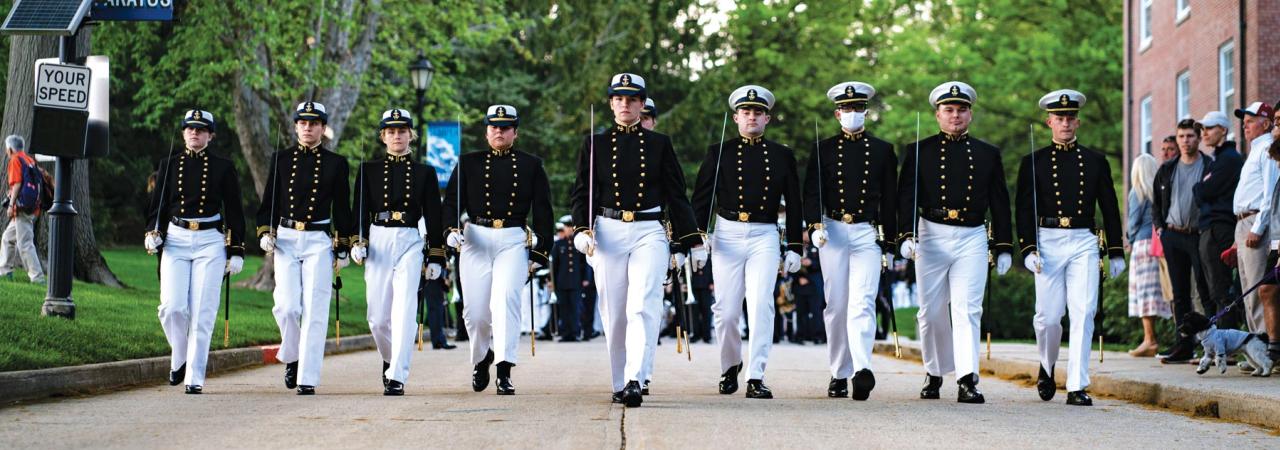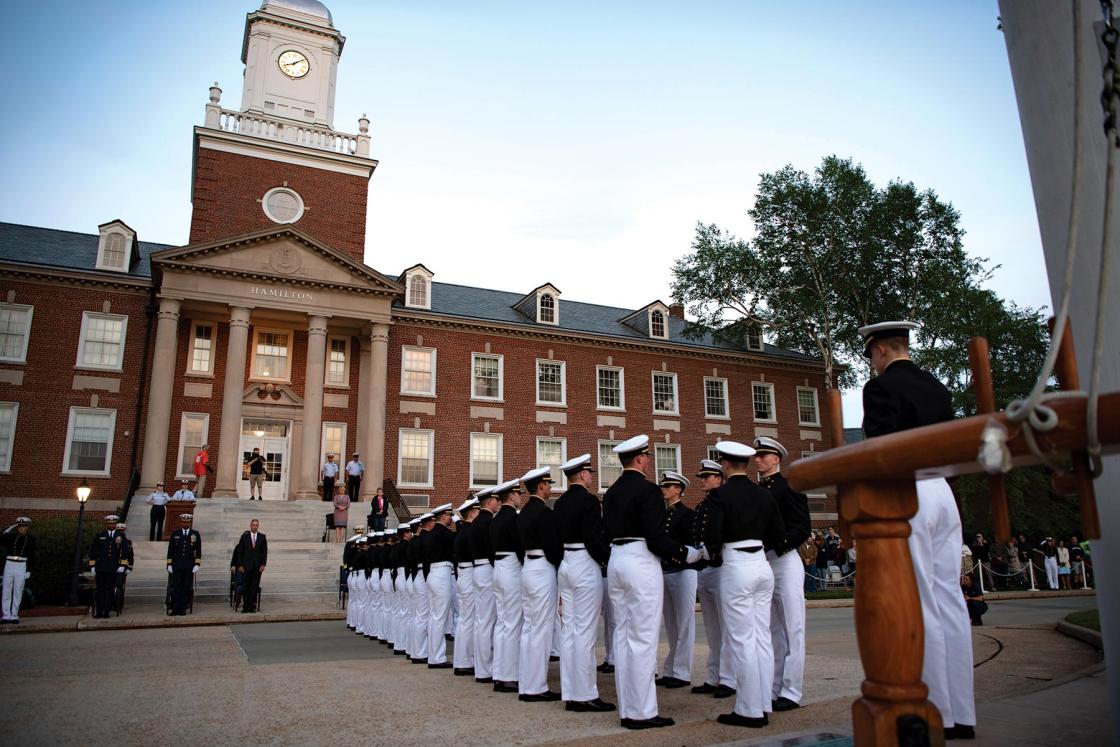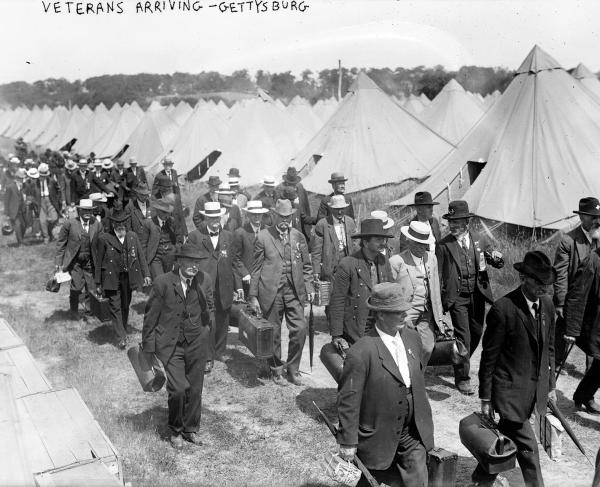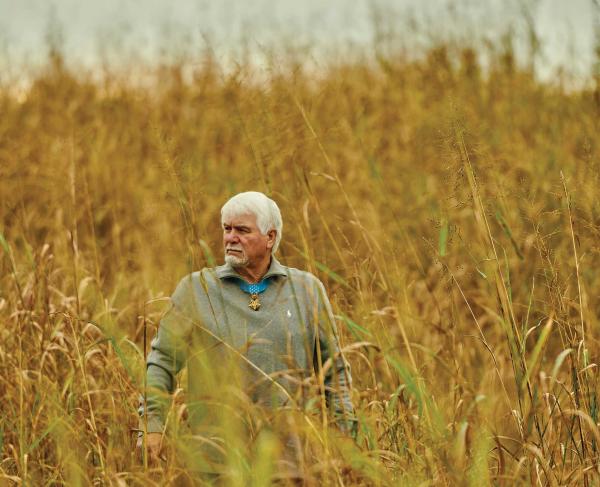U.S. Coast Guard Academy in New London, Conn.

Sunset regimental review at U.S. Coast Guard Academy, New London, Conn.
As part of a series on military service academies, Darran McLenon, Class of 1991, reflects on his experience at and the history of the U.S. Coast Guard Academy in New London, Conn.
The U.S. Coast Guard has come a long way from the Alexander Hamilton-inspired Revenue Cutter Service of the late 1700s, and its accompanying service academy has been through quite the evolution itself.
The first Coast Guard Academy began aboard the topsail schooner Dobbin, which set sail from Baltimore, Md., in 1876, for a two-year training cruise. Cadets were trained on the open ocean until 1900, when the first campus was established on solid ground in Curtis Bay, Md. After 10 years, the academy was moved to Fort Trumbull, a Revolutionary-era fort in New London, Conn. Remaining in the town, the academy shifted to the 90 acres it sits on today in 1932 when members of the town donated the land to the U.S. Treasury Department, which, at the time, oversaw the Coast Guard.
This acreage is what I came to know when I attended the U.S. Coast Guard Academy (USCGA) from 1988 to 1991. For a guy from Monroe, Mich., I had no idea what I was walking into. As soon as I went through the gates, I was catapulted into an English-type campus with history at every turn. The buildings are old, and everything is polished. It’s on the Thames River, but it’s also on a hill! I walked up and down that hill amongst statues, monuments and the museum, but was kept so busy that, at times, the scenery was a blur.

It wasn’t until 1941 that cadets were granted a bachelor of science degree in addition to their commission as an ensign in the U.S. Coast Guard, and the years following greatly expanded academic options. In the sixties, the number of faculty increased, a system of academic honors was established and elective courses were first offered. Today, cadets can receive their degree in eight different majors: Civil and Environmental Engineering, Electrical Engineering, Cyber Systems, Mechanical Engineering, Naval Architecture and Marine Engineering, Operations Research and Computer Analysis, Marine and Environmental Sciences, Management and Government.
I thought I was smart in high school, but the academy is no joke. Being the only federal service academy that does not require a congressional nomination, competition for admission was — and remains — fierce. So, I entered with an elite bunch and was presented with 25-32 credit hours each semester; 16- and 17-hour days were typical. With a balance of academics, sports and leadership training, it’s this rigorous schedule that makes or breaks a cadet.
Frankly, I didn’t know I would graduate until that fourth year, and the support system I found in the baseball team made all the difference. Out of the 330 I started the academy with, I crossed the finish line with about 205 cadets. The tiring moments I endured made it difficult to fully appreciate the history in the moment, but looking back, it was truly woven into the academy experience.
One piece of history that we literally sailed upon is the tall ship Barque Eagle. The 295-foot ship, received as a war prize from Germany after World War II, serves as a training tool and is the only active-duty sailing vessel in the U.S. military. It is actually a requirement for all USCGA cadets to venture out on the vessel. For four summers, I was on the Eagle, taking in sights I never thought I’d see as a kid from Michigan.

However, the rigors of the sea were intense as a young “Coastie” because the ship operated on mostly sail power. I was reminded of the ship’s historic nature when I’d climb into the rigging and masts that were more than 100 feet tall. While intimidating then, I can look back now and say I’m lucky to have had such an experience. I can also — without a doubt — claim that the academy’s motto, Scientiæ cedit mare (Latin for “the sea yields to knowledge”), applied to my time on the Eagle and my many years following as a sailor.
The academy, and my Coast Guard career as a whole, gave me a gift in the form of fellowship. Of the 200-something individuals I graduated with, there’s not one of them I couldn’t call on today.


